D6.3: MoU and SLA templates for data interoperability
The aims and structure of the deliverable
This deliverable examines how two types of legal documents – Memorandum of Understanding (MoUs) and Service Level Agreement (SLAs) – could promote data interoperability within the European Open Science Cloud (EOSC) Federation.
In the context of EOSC, data interoperability depends on all four interoperability dimensions: legal, organisational, semantic and technical. Research data repositories, as intermediaries between data producers (researchers) and data users, are identified in this deliverable as central to establishing and maintaining data interoperability as a service.
By their very nature, MoUs and SLAs are key tools for organisational interoperability, as they describe working processes that allow stakeholders with different business processes to work together.
SLAs provide a framework between a provider and a customer for defining service delivery, helping providers to articulate service guarantees and giving users a clear understanding of service expectations. MoUs, on the other hand, are strategic agreements that bring together stakeholders with common goals, making them ideal for fostering collaboration within communities. While SLAs focus on service delivery, MoUs are used to align broader strategic interests.
These agreements can enable more user-centred and efficient service and process development. Including data interoperability in relevant documents or if feasible writing separate documents would be important to take interoperability forward.
While both types of agreements clearly enhance organisational interoperability by enabling stakeholders to align business processes towards common goals, there is currently a significant gap in accessing and harmonising all the guidelines to support interoperability in the legal, semantic and technical dimensions. Today, the evolving EOSC federation lacks a robust, community-endorsed framework for systematically describing and enforcing data interoperability, highlighting the need for such guidelines.
Given this lack of compliance to common standards, the considerable diversity of service providers and the EOSC's transition to a federation, the provision of standard templates for agreements is premature. A fundamental step before developing agreements is to assess the capacity of the organisations involved to inform the development of effective agreements.
Rather than providing agreement templates, this deliverable proposes recommendations and guidelines to help service providers self-assess their capabilities and thus enable them to design agreements that are appropriate to their specific capabilities. The guidelines in the appendices support the development of SLAs and MoUs for data interoperability by providing structured recommendations that offer both a model for drafting agreements and the flexibility to adapt to different contexts.
Data interoperability standards to be included in MoUs and SLAs
In the context of EOSC, the backbone of interoperability is the EOSC Interoperability Framework (EOSC-IF). It breaks down interoperability into four key categories: legal, organisational, semantic and technical.
The EOSC-IF is a written document designed to be open and adaptable, with the aim of
lowering barriers to entry for both users and providers. Interoperability standards are often
dynamic, evolving in response to the specific context in which data are shared and reused. Given the diversity of scientific fields, each with its own policies and practices, it is challenging to create a universal set of standards that can address all the nuances of data interoperability. A one-size-fits-all approach may not meet the different needs of each domain. This diversity limits the feasibility of integrating the standards and recommendations outlined in the EOSC IF into rigid, formal documents such as MoU and SLA templates.
In the future, as the technical requirements for data interoperability within the EOSC
framework become more detailed, they will directly influence the design of SLAs and MoUs
for data interoperability within the EOSC community.
The interoperability recommendations selected in this context focus specifically on the ability to move and reuse data with clear context and without unnecessary barriers - i.e. data interoperability. This focus excludes other types of interoperability, such as those related to the compatibility of software and IT systems with each other. While some recommendations within the EOSC-IF may apply to both contexts, the aim here is to provide a more detailed understanding and definition of data interoperability.
| Data interoperability is the capacity to combine and use data from disparate digital tools with ease, coherence and efficiency. |
Using this framework, we identify data interoperability requirements that could shape the development of SLAs and MoUs.
The recommendations cover all four types of interoperability (legal, organizational, semantic, and technical) and are grouped into two main areas:
- For service providers: guidance on how to describe and implement data services that ensure data interoperability.
- Agreement format: advice on how to design SLAs and MoUs that are accessible and promote data interoperability.
Recommendations for legal interoperability
This section considers what would be required of service providers to achieve legal interoperability. Some of the criteria and recommendations can be acted upon directly by service providers, whilst others have stronger implications for the work of data providers (i.e. the data depositor/owner, researcher/data collector) and/or the EOSC Federation itself and other actors.
| Legal interoperability refers to “the ability to combine datasets from multiple sources without conflicts among restrictions imposed by the license of each dataset.” It also concerns cases where access to data ‘is restricted or subject to conditions’ in which case the conditions for access and use should be “clearly and readily determinable through automated means,” and they “should not conflict with each other.” - Link |
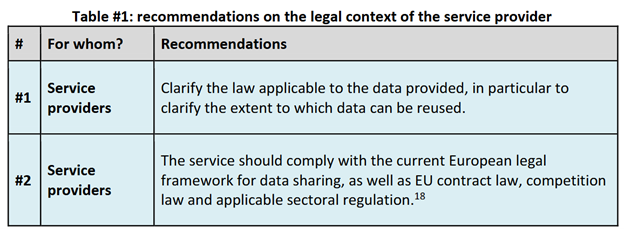
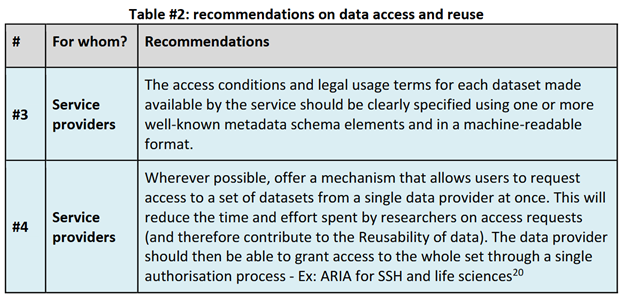

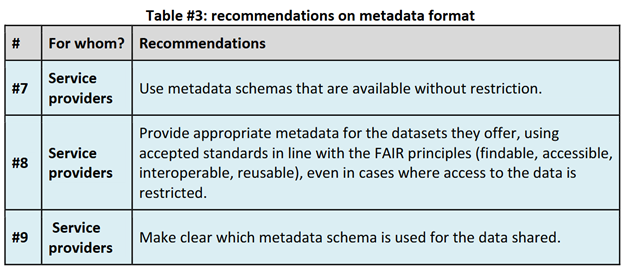
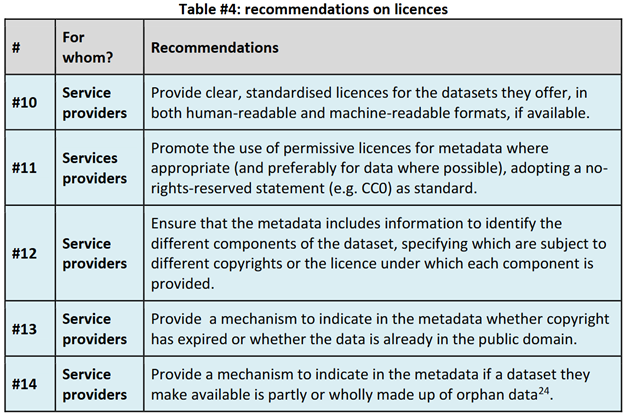
Recommendations for organizational interoperability
Organisational interoperability is the least-discussed aspect of interoperability. Although many challenges have been identified, few concrete solutions exist.
MoUs and SLAs play a key role in enabling interoperability and should be scalable. Indeed, through the relationship between either service providers and users or stakeholders with common interests, they allow the documentation of business processes within a written document and explain how different business processes can be aligned. They also allow the formalisation and clarification of organisational relationships.
| Organisational interoperability refers to “the way in which organisations align their business processes, responsibilities and expectations to achieve commonly agreed and mutually beneficial goals. In practice, organisational interoperability means documenting and integrating or aligning business processes and relevant information exchanged. Organisational interoperability also aims to meet the requirements of the user community by making services available, easily identifiable, accessible and user-focused.” - Link |
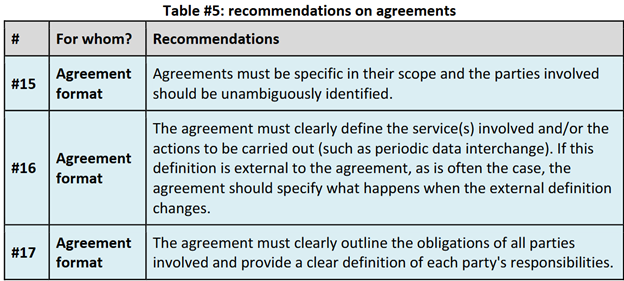
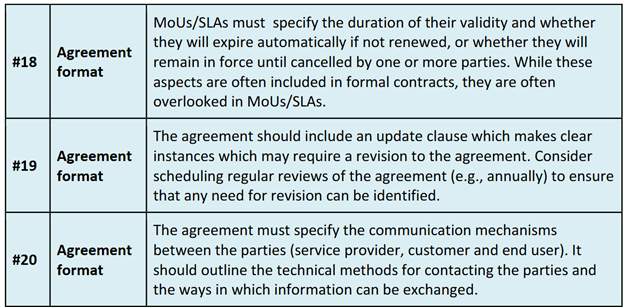
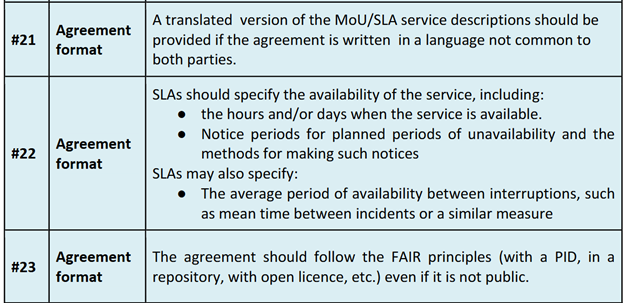

SLAs and MoUs for data interoperability: Suggestions for implementation
In the context of data interoperability, the creation of MoU and SLA templates for service providers and data customers/users will enhance interoperability. Explicitly including interoperability in these documents OR producing separate interoperability SLAs would likely promote implementation of the FAIR data principles. These agreements, though not necessarily legally binding, clarify commitments in the context of working / service relationships. If the interoperability requirements are consistent across service providers offering similar services, overall interoperability will improve.
SLAs: Focus on data repositories
SLAs are key documents to clarify how a service is provided and for increasing confidence in the provision of the service. In the context of this deliverable, the focus is on SLAs between research data repositories – which collect, store and curate the (meta)data – and their customers / users, who expect the data to be interoperable so that it can be reused in another context.
Data repositories are key stakeholders with the greatest potential to improve data interoperability. While laboratories / scientific instruments, as primary data producers, have a direct impact on data quality, they generally lack the broader perspective and tools required to manage data at scale and do not fulfil the role of service providers. In contrast, data repositories are seen as primarily responsible for managing data and ensuring its interoperability. This responsibility is achieved by implementing appropriate data exchange protocols, defining formats that support data reuse, applying metadata standards that meet interoperability requirements, and addressing the legal and governance considerations associated with the data they share. By facilitating access to and reuse of research data at a defined level of quality, data repositories are positioned as the primary actors likely to issue SLAs within the data interoperability landscape.
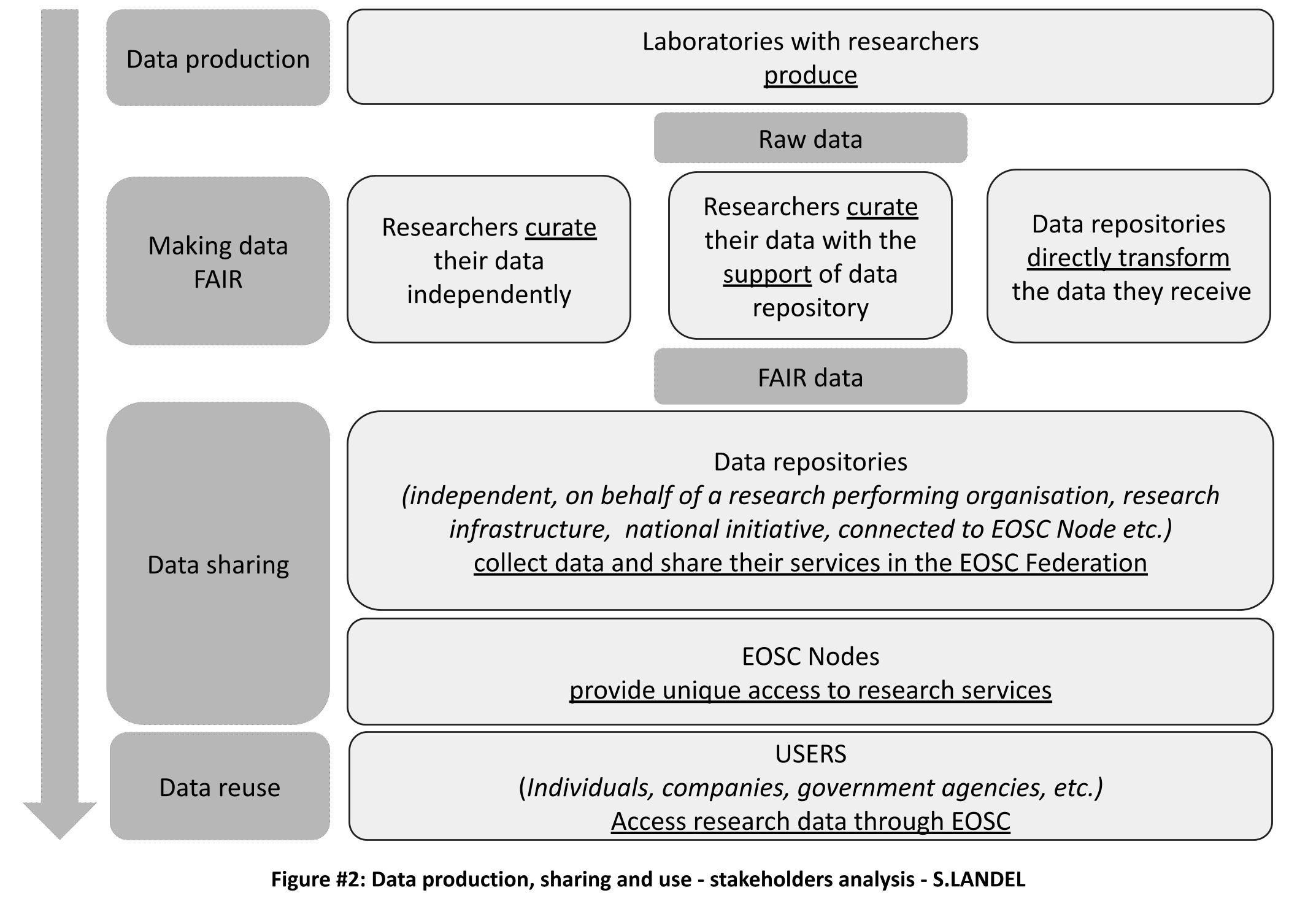
MoUs: Suggestions for implementations
In the context of EOSC and data interoperability, MoUs have several applications. Due to their less binding and service specific nature, they serve as tools to initiate alignment between stakeholders. Data interoperability in this case can be seen as the alignment of standards across communities. As EOSC initiatives bring together organisations, service providers and users from different scientific fields and countries, MoUs are instrumental in synchronising their efforts towards a common goal which can be data interoperability.
The different options for MoUs and data interoperability are summarized in the Figure.
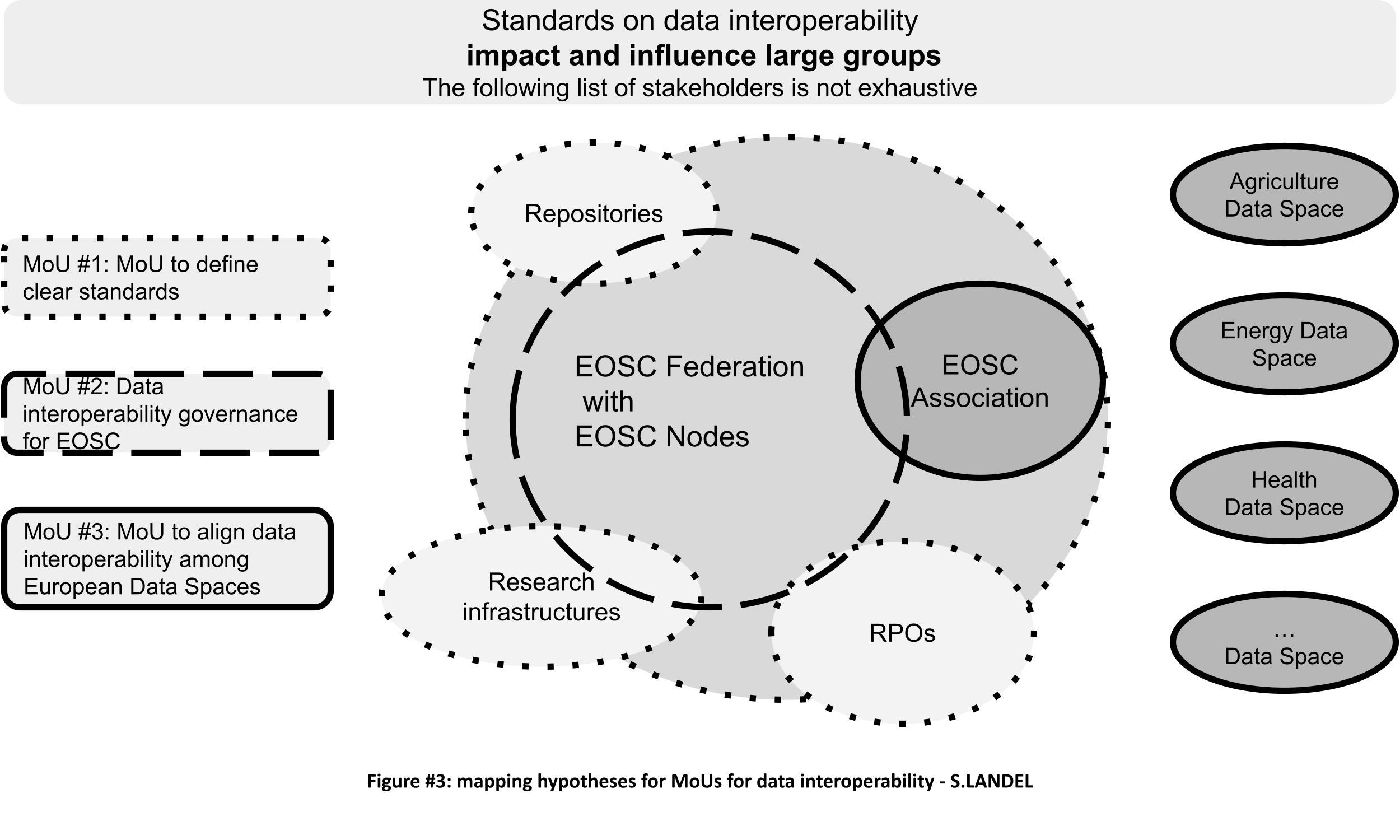
Conclusions and next steps
The guidelines for SLAs and MoUs presented in this deliverable are deliberately designed to be flexible. Their purpose is twofold: firstly, to encourage service providers to articulate how their organisation delivers and, to some extent, guarantees data interoperability to their users; and secondly, to provide a framework that encourages collaboration between relevant stakeholders. This collaborative approach aims to refine the definition of data interoperability and outline its practical implementation. Moving from fuzzy definitions to clear standards within the EOSC community, backed by agreements, will improve data interoperability and enable a key part of it: organisational interoperability.